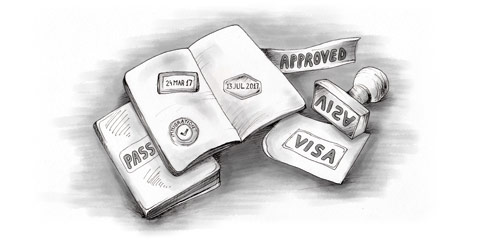The unpleasant aspect of Italy’s dog population is abundantly evident on the streets of Italian towns and cities, where dogs routinely leave their ‘calling cards’. You must always watch where you walk.
Most dog owners don’t take their pets on long country walks, but just to a local park or car park or simply let them loose in the streets to do their business. Poop-scoops must be used in some cities and towns, where you can be fined around €30 for not cleaning up after your dog, though most people ignore this law. Although it’s of little consolation, it’s supposedly good luck to tread in something unpleasant!
Importing pets to Italy
If you plan to take a pet (animale domestico) to Italy, it’s important to check the latest regulations. Make sure that you have the correct papers, not only for Italy, but for all the countries you will pass through. Particular consideration must be given before exporting a pet from a country with strict quarantine regulations, such as the UK; if you need to return prematurely, even after a few hours or days, your pet may need to go into quarantine, e.g. for six months in the UK.
Quarantine for bringing pets to Italy
There’s no quarantine for healthy pets arriving in Italy, but they need an ISO Standard microchip implant (or equivalent, with appropriate scanner), and an veterinary health certificate (bilingual, Italian-English) issued by an approved veterinary surgeon.
Dogs and cats need a rabies vaccination not less than 20 days or more than 11 months prior to the date of issue of the health certificate. Those aged under 12 weeks are exempt but must have a health certificate and a certificate stating that no cases of rabies have occurred for at least six months in the local area.
Pets entering from countries with a high incidence of rabies must have a certified rabies blood test one month after their initial vaccination, and also at least 3 months prior to arrival in Italy.
Transporting your pet
If you’re transporting a pet by ship or ferry, you should notify the shipping company. Some companies insist that pets are left in vehicles (if applicable), while others allow pets to be kept in cabins. If your pet is of nervous disposition or unused to travelling, it’s best to tranquillise it on a long sea crossing.
Pets can also be transported by air, although conditions and regulations will vary between airlines. Check with your preferred carrier well in advance to determine whether you will be required to transport your pet in the hold or if they allow small animals to be transported in suitable containers in the cabin with you.
Identification
At the age of three months, a dog must be registered at the local ‘dog bureau’ (anagrafe canina) and some municipalities issue dog tags. Italian regulations used to require dogs to be tattooed on their body (not just their ear) as a means of registration, but the microchip identification system has gradually replaced this practice.
Dogs and cats don’t need to wear identification discs in Italy and there’s no system of licensing (a dog tax was abolished because most people claimed their dogs were working animals and refused to pay it). However, it’s recommended to fit your dog with a collar and a tag containing your name, address and telephone number.
Lost dogs are taken to the local pound and may be put down if the owner cannot be found. All dogs must be kept on a leash and (if dangerous) muzzled in towns or on public transport, but not in the country. You must usually pay full fare on public transport for a dog that isn’t carried and large dogs may be prohibited from travelling on public transport.
Pet vaccinations and native diseases in Italy
Required vaccinations for pets
Dogs: Distemper, Hepatitis, Parvo, Leptospirosis, (DHLPP) and Rabies within the last 12 months or a minimum of 4 weeks before arrival.
Cats: Feline Viral Rhinotracheitis, Calicivirus, Panleukopenia (FVRCP), and Rabies within the last 12 months or a minimum of 4 weeks before arrival.
There are a number of diseases and dangers for pets in Italy that aren’t found in most other European countries, including the fatal leishmaniasis (also called Mediterranean or sandfly disease. Unfortunately this disease cannot be cured once contracted, so all reasonable preventative steps should be taken such as, using a spray such as DefendDog, and minimising your pet’s time out of doors at night and during the hottest part of the afternoon.
Obtain advice about this and other diseases from a veterinary surgeon (veterinario) on arrival in Italy.
Insurance & welfare
Take extra care when walking your dog, as some have died after eating poisoned food, which is sometimes laid by hunters to control natural predators. Don’t let your dog far out of your sight or let it roam free, as dogs are often stolen or mistakenly shot by hunters.
Health insurance for pets is available from a number of insurance companies (vets’ fees are high in Italy) and it’s wise to have third-party insurance in case your pet bites someone or causes an accident. In areas where there are poisonous snakes, some owners keep anti-venom in their refrigerator (which must be changed annually).
The Ente Nazionale per la Protezione degli Animali (www.enpa.it) is the main organisation for animal welfare in Italy and it operates shelters for stray and abused animals, and inexpensive pet hospitals in many cities.
This article is an extract from Living and Working in Italy. Click here to get a copy now.

